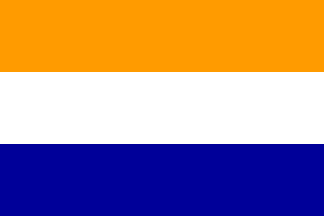 image by
Martin Grieve, 01 July 2008
image by
Martin Grieve, 01 July 2008
Last modified: 2022-10-22 by bruce berry
Keywords: afrikaners | boers |
Links: FOTW homepage |
search |
disclaimer and copyright |
write us |
mirrors
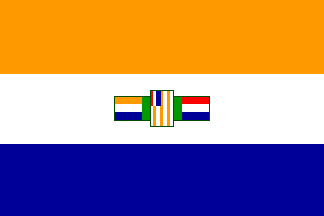 image by
Martin Grieve, 01 July 2008
See also :
image by
Martin Grieve, 01 July 2008
See also :
In January 2004 a conference to debate the issue of a new "Afrikaner" flag
was held during which all previously 'Afrikaner' flags were outlined to the
delegates. The Afrikaners have used about twenty flags
through their history, excluding some which included the Union Jack! The most
important outcome of the conference was the establishment of a heraldic
committee, out of which the 'Genootskap vir Afrikaner Simbole' (GAS)
(Fellowship of Afrikaner Symbols) was formed.
The main task of this fellowship was to design a flag for the Afrikaner or "Boer"
people in South Africa. Although seen as a part of
the broader South African community, the Afrikaners nevertheless consider
themselves as a separate 'nation' with a distinctive language, culture, and
faith.
Over a period of three years GAS engaged with the broader Afrikaans community
regarding the proposals for the design of a new flag to represent during which
67 proposals were received. These proposals were evaluated on the basis of the
following criteria:
* Must comply with general international heraldic principles.
* There should be a good balance between the will of our people and heraldic
principles.
* The advantages and disadvantages of every flag would be thoroughly considered.
* The flags must be designed in consideration of existing regional struggle
songs and the national anthem.
* Provision must be made for regional flags should these develop in future.
* Flags must be designed in consideration of possible future military ensigns.
* However, the most important aspect was that the flag design must have the
ability to unite Afrikanerdom.
The submitted proposals were categorised under the following headings:
1. 'Prinzenvlag' base flags;
2. 'Vierkleur' (4 colour) base flags;
3. Canton base flags;
4. Cross flags;
5. Monument flags; and
6. Other.
Of the 67 proposals submitted, only 25 met the above-mentioned criteria and a
further process of evaluation resulted in another five of the proposals being
eliminated, leaving only 20 proposals to be considered. On 17 February 2007, a
number of prominent Afrikaners were invited to discuss the short-listed
proposals, some of which are shown below.
The results of the research sessions showed that 90% of the delegates wanted
orange, white and blue (the colours of the former South
African flag which was based on the Prinzenvlag) as a basis for the
new flag. The next requirement was that the 'Vierkleur' must be included
followed by the Free Staters demanding that the 'Vrystaatvlag'
must also be included. Thus, the conclusion was that the design of former South
African national flag should form the basis for the new flag design. The
only question was what should then replace the 'Union Jack? Three
possibilities were considered : the Natalia flag, the
Nieuwe
Republiekvlag and the 'Vryburgervlag'. Four proposals which had
scored the highest points were published in Die Afrikaner of 11 - 17 May 2007
and readers were given a month to give their opinions and to make their final
choice.
On 31 May 2007 (formerly Republic Day in South Africa) GAS selected a new
"Afrikaner flag" and on 10 October 2007 (Paul Kruger and Boer Heroes Day) this
Afrikaner flag, together with three regional struggle flags, was unveiled.
The new Afrikaner flag can be described as follows:
Three horizontal parallel stripes of orange, white and blue in the proportion of
2:3. In the centre of the white stripe is the 'Vrystaatvlag',
hanging vertically. Adjacent to the 'Vrystaatvlag' with its green stripe
of 'Good Hope', and facing the fly, is the Transvaal 'Vierkleur'; and
with its green stripe of 'Good Hope' facing the hoist, is the 'Vryburgervlag'
of the Cape of Good Hope. Thus, the three former
provinces are connected with Good Hope and are all even in stature.
The symbolism of the Afrikaner flag is as follows: The basis of orange, white
and blue horizontal stripes follows the Protestant tradition. The orange
specifically symbolises the protestant faith, the white the
purity of race (with specific reference to Caucasians), and blue the divinity of
God on which all moral values are built. The cross formed by the regional flags
in the middle of the white stripe confirms the
Afrikaner's Christian faith.
The 'Vrystaatvlag" represents all Free Staters who have associated
themselves with the freedom struggle of the Afrikaner. The Vierkleur
represents the Transvalers, as well as certain Afrikaners in the
northern parts of Natal who have also associated
themselves with the freedom struggle of the Afrikaners. The 'Vryburgervlag'
represents the 'Cape rebels' who fought on the side of the two Boer republics
against Britain during the Anglo-Boer War (1899 - 1902) and who were murdered
when discovered by the British. Therefore the historical significance of the new
Afrikaner flag is that the flag actually symbolises the commemorations of the
Anglo-Boer War when mounted Boer Commandos of the
Transvaal spontaneously used the 'Vierkleur', Free Staters their 'Vrystaatvlag'
and Cape Commandos the 'Vryburgervlag' (at that stage the 'Vryburgervlag'
was called the 'Cape Rebel flag') as symbols of their various provinces. (The
latter flag was handmade and is still in existence).
According to GAS, the new Afrikaner flag is thus in essence the previous South
African national flag which many Afrikaners still cherish, replacing the 'Union
Jack' with the 'Vryburgervlag', thus making it a
pure Boer Republican flag.
Bruce Berry, 09 July 2008
Some of the shortlisted designs considered by GAS for a new Afrikaner flag were
the following:
 image by
Martin Grieve, 01 July 2008
image by
Martin Grieve, 01 July 2008
The 'Prinzenvlag' was the basis of the former South African flag and is considered to be the first flag flown in South Africa, being the Dutch flag at the time that Jan van Riebeeck arrived in Table Bay on 06 April 1652.
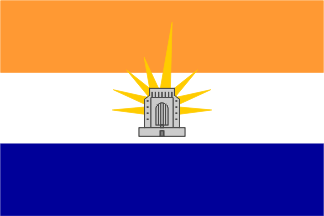 image by
Martin Grieve, 01 July 2008
image by
Martin Grieve, 01 July 2008
The 'Prinzenvlag' defaced with a representation of the Voortrekker Monument and stylised sun's rays.
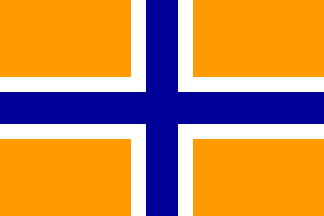 image by
Martin Grieve, 01 July 2008
image by
Martin Grieve, 01 July 2008
The so-called "Graaf Reinet" flag was the runner-up design.
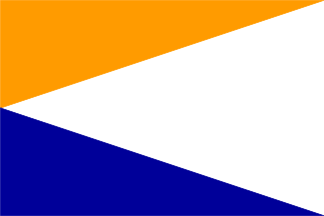 image by
Martin Grieve, 01 July 2008
image by
Martin Grieve, 01 July 2008
A design which is based on the flag of Natalia, but with the upper stripe in orange rather than red.
 image by
Martin Grieve, 01 July 2008
image by
Martin Grieve, 01 July 2008
A design based on the former flag of the Orange Free State but with the Transvaal Vierkleur (four colour) in the canton instead of the Dutch flag.
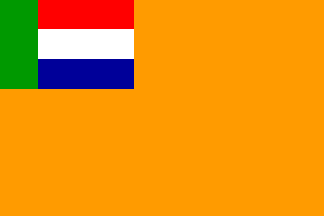 image by
Martin Grieve, 01 July 2008
image by
Martin Grieve, 01 July 2008
A simple design having an orange field with the Transvaal Vierkleur in the canton.
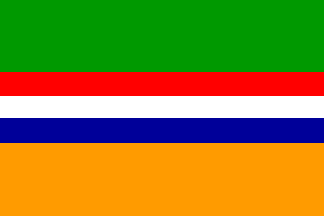 image by
Martin Grieve, 01 July 2008
image by
Martin Grieve, 01 July 2008
One of the more original designs, this proposal included all the Boer republican colours.
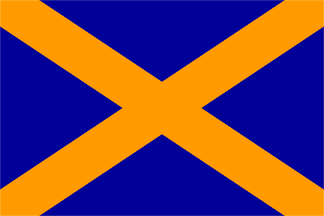 image by
Martin Grieve, 01 July 2008
image by
Martin Grieve, 01 July 2008
This design is based on the 'Kruisvlag' of the Voortrekkers but with the saltire in orange instead of red.
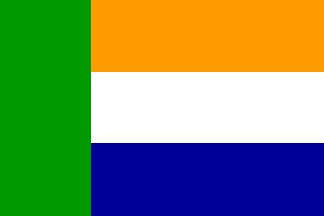 image by
Martin Grieve, 01 July 2008
image by
Martin Grieve, 01 July 2008
This design is based on the Transvaal Vierkleur but with the upper horizontal stripe being orange instead of red. This design is also referred to as the 'Strydvlag' (literally Struggle flag).
 image by
Martin Grieve, 01 July 2008
image by
Martin Grieve, 01 July 2008
A design based on the former national flag of South Africa, but the the central white stripe containing the Transvaal Vierkleur on the left and the flag of Natalia on the right of the Orange Free State flag (hanging vertically).
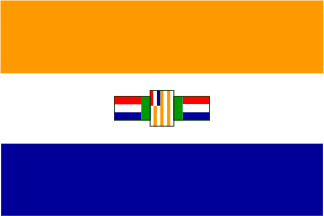 image by
Martin Grieve, 01 July 2008
image by
Martin Grieve, 01 July 2008
Another design based on the former South African flag
but with the Transvaal Vierkleur being placed
on both sides of the Orange Free State flag (hanging
vertically in the centre).
Bruce Berry, 09 July 2008